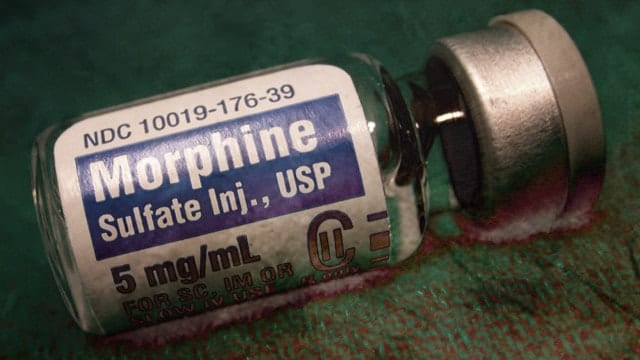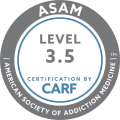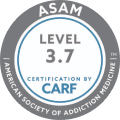
Morphine is a narcotic pain reliever that was first developed in 1805 and widely used during the Civil War. Today, it is available in tablet, liquid, and injectable forms and is used to treat both acute and chronic pain. As one of the oldest opioid medications that are still in use, it has a particularly high rate of unpleasant side effects and dependency.
What Conditions Can Morphine Treat?
Morphine is intended for the treatment of moderate to severe pain. It is commonly used in hospitals for patients who have acute pain from an accident or other traumatic injuries. In addition, morphine is often prescribed for patients with chronic pain from cancer or fibromyalgia and for severe back pain, kidney stones, and breakthrough pain.
What Precautions Are Needed When Prescribing This Medication?
Morphine should be used with caution in pediatric and geriatric patients. Ideally, women who are pregnant or breastfeeding should not use this medication. Morphine may not be appropriate for those who have experienced intestinal blockages, seizures, swallowing difficulties or low blood pressure. Due to the risk of serious breathing problems, individuals with lung disease, asthma and COPD should not use morphine.
Due to the high risk of dependency, people who have had substance use issues should not be prescribed this medication. If used with alcohol, morphine can cause life-threatening breathing problems. Individuals who struggle with alcohol use should use another medication to control their pain. Caution should be used when prescribing this medication for patients who have had a head injury and for those who are malnourished or frail.
What Drugs Interact With Morphine?
Morphine has a particularly high number of drug interactions that may lead to potentially life-threatening side effects. Prior to taking this medication, tell your doctor about all prescription, over-the-counter, herbal or homeopathic medicines that you take. Morphine interacts with several supplements, including Saint-John’s-wort and tryptophan. Antihistamines, selective serotonin reuptake inhibitors, diuretics, certain cough medicines and drugs used to treat migraines are some of the most common prescription drugs that interact with morphine.
In particular, morphine interacts with a variety of medications used in the treatment of mental health conditions. For example, it is known to interact with lithium and tricyclic antidepressants. Morphine also interacts with naltrexone and with the opioid buprenorphine, a medicine that is found in Suboxone. Suboxone is used to treat substance use issues involving opioids.
How Do You Take Morphine?
If using the oral solution of this medication, one dose can be taken every four hours. The oral solution should only be measured out using the included dosing cup or dosing syringe; household spoons or cups are not precise enough.
If you have been prescribed one of the extended-release tablets for this medicine, the exact dose will vary depending on which brand of the tablet has been prescribed. Extended-release tablets that are the MS Contin or Arymo ER brands are normally taken every eight to 12 hours. Morphabond branded tablets should usually be taken once every 12 hours, and Kadian branded tablets can be taken every 12 or every 24 hours.
Some people may have trouble swallowing morphine tablets. To make this process easier, the extended-release capsules can be opened. After opening the capsule, all of the beads inside it should be placed in a spoonful of cold or room-temperature applesauce or pudding. The entire spoonful should then be consumed immediately.
If a dose of this medicine is missed, the missed dose should be skipped, and people should resume their regular dosing schedule. Doses should not be doubled. Morphine can normally be taken with or without food.
What Side Effects May Occur With Morphine?
Morphine side effects range from mild to severe. Some of the mild morphine side effects that commonly occur in patients include constipation, cramps, drowsiness, and weight loss. Some people may also experience dry mouth, vision changes, menstrual irregularities, muscle stiffness, muscle control issues, and indigestion.
Less common morphine side effects that are more serious include chest pain, burning or tingling sensations, chills, fainting, dizziness and a fast or irregular heartbeat. Nervousness, increased sweating, coughing, pounding in the ears, and eyelid or facial swelling have all been reported. This medication can also cause swallowing difficulties, overactive reflexes, shallow breathing, and agitation. These side effects should be reported to a physician immediately.
Although the following side effects are rare, patients taking this medication have experienced strange dreams, walking and balance difficulties, and confusion. For example, a person may have trouble recognizing objects or people and could develop very strong beliefs that are false and have no basis in reality. He or she might display an unusual sense of excitement, and hallucinations have been noted. Clinicians should be informed of any of these changes.
What Are Potential Signs of a Morphine Use Issue?
People who use morphine may develop a dependency, particularly if they have been on high doses of the medicine or used it for a long period. Caregivers, family, and friends should familiarize themselves with these signs so that their loved one can receive the proper support.
Those who have developed a morphine use issue may have frequent mood swings or become irritable or depressed. They might also sleep more often than usual, lose interest in their work or other responsibilities, and have reduced motivation. Their decision-making may be inhibited, and they may have panic attacks. Alternatively, some individuals could experience a sense of euphoria.
Physical symptoms that typically accompany an opioid use issue include slurred speech, nausea, vomiting, sleepiness, and impaired coordination. Patients may also appear physically agitated, and constipation may develop. Some people might have shallow breathing or breathing that seems a lot slower than is normal for them.
What Are Morphine Withdrawal and Detox?
Withdrawal, also known as detox, is a natural process that the body undergoes in order to rid itself of all traces of morphine and other drugs. This process normally begins after the person stops taking morphine, and it may also start if the person’s normal dosage is reduced.
Withdrawal may start within hours or days of taking the last dose of morphine. The active withdrawal period in which people experience physical symptoms typically lasts around a week. Emotionally, the withdrawal process may take several months to complete with the help of counseling and support groups.
The physical symptoms of withdrawal vary from person to person. Generally, people can expect to experience anxiety, agitation, and trouble sleeping in the early stages of the detox process. They may also experience sweating, yawning, a runny nose and low blood pressure.
In the later stages of withdrawal, symptoms often include dilation of the pupils, abdominal pain, cramping, and diarrhea. Patients may have nausea or vomiting, and goosebumps may develop.
How Can You Detox From Morphine?
Both morphine use and the withdrawal process can cause serious cardiovascular, respiratory and abdominal issues. Therefore, medically supervised detox is recommended. This process usually takes place in a hospital or in a residential treatment facility. Medically supervised detox uses medications and psychological support to make detox as safe and as comfortable as possible, and it can give you the highest chance of a successful recovery.
What Can You Expect During a Medically Supervised Detox Program?
While staying at a medically supervised detox program, your health and vital signs will be monitored frequently. Medications to treat nausea, vomiting, pain and other symptoms can be administered to help you, and you’ll also have daily therapy sessions with a counselor.
When you first arrive at a treatment facility, you’ll be asked to fill out a health history form that asks questions about your medication use, mental health and personal and family history of heart disease, high blood pressure, breathing problems, cancer, and other health conditions.
To provide the most appropriate treatment during your stay, you’ll have a physical exam with a doctor shortly after you arrive. This exam will help establish your baseline health measurements and enable the medical staff to address any areas of concern.
To begin the physical exam, the doctor will measure your height, weight, temperature, blood pressure and pulse. Since morphine can strongly affect the cardiovascular, respiratory and gastrointestinal systems, the physical exam will focus on these areas.
The doctor will use a stethoscope to listen to your heart and lungs. He or she will be listening for abnormal heart sounds, a heart rate that is too fast or too slow, and irregularities in the heart’s rhythm. While listening to your breathing, the doctor will check that your breathing sounds are clear and that you don’t have any signs of labored breathing, congestion or wheezing.
Abdominal cramping, constipation, and diarrhea are common when undergoing detox from morphine, so the doctor will gently assess this area. He or she will feel your abdomen for lumps or rigid areas that may suggest constipation, and you’ll also be asked about any pain or cramping in the area.
After the physical exam, you’ll be shown to your living space. Over the course of your stay, nurses will check your vital signs several times a day. You should report any pain, anxiety, vomiting or other symptoms, and you can receive medication as needed. Intensive group and individual therapy sessions are provided to teach you coping skills that will help you during and after your stay.
What Medications Can You Have During Detox?
Depending on the severity of your symptoms, you may need multiple medications during your withdrawal. Methadone, naltrexone, and buprenorphine are commonly used to treat opioid withdrawal, and they can help reduce the length of the detox period and prevent relapse. However, since these drugs all interact with morphine, medical staff at the detox center will decide whether alternative medicines may be needed instead.
To make the withdrawal process less unpleasant, you can receive additional medications to manage nausea, vomiting, anxiety, insomnia and other physical and emotional symptoms that may happen during detox. The exact medication you receive will depend on your overall health status. Always be open with treatment facility staff about your symptoms so that they can help you.
What Kinds of Counseling Will You Have?
During your stay, you’ll receive treatment with a variety of counseling methods. These will provide you with the broadest possible range of coping skills. You’ll have a chance to share your story in group sessions, and individual sessions will help you build strength and resilience.
Cognitive behavioral therapy is one of the most widely used therapies for the treatment of substance use issues. This method focuses on replacing the negative thoughts that can lead to morphine use with more positive ones that may enable you to break the cycle of opioid use. You’ll learn how to identify your triggers, and your therapist will teach you about ways to avoid them and coping strategies for when avoiding a trigger isn’t possible.
Cognitive behavioral therapy is sometimes used in conjunction with motivational interviewing and family or couples therapy. These therapies provide you with a larger base of support, and they can also help with building stronger, more positive relationships with your loved ones.
How Can You Get Treatment at a Medically Supervised Facility?
The first step to arranging treatment is to speak with your primary care doctor. Let him or she knows that you have been struggling with morphine use and that you’d like to have medical supervision to recover. He or she should know of the facilities in your area that have the highest rates of successful treatment and the ones that are best-equipped to care for your health needs.
The Substance Abuse and Mental Health Services Administration provides information about access to treatment resources in each state. They can also assist Medicare and Medicaid patients with finding treatment options, and they can help uninsured patients find providers and facilities that operate on a sliding scale.
What Can You Do to Give Yourself the Best Chance of Recovery?
Morphine has a particularly high dependence rate, so it is important that you get help as soon as you or those around you notice that there is an issue. Talk to your doctor about reducing your morphine dose or switching to a non-opioid pain reliever, and also ask about medications that can reduce your dependency on morphine. Always seek professional advice for this health concern, and remember that you are not alone. The sooner you seek help, the sooner you can recover.






